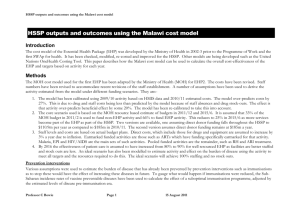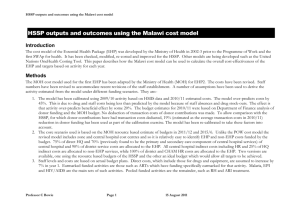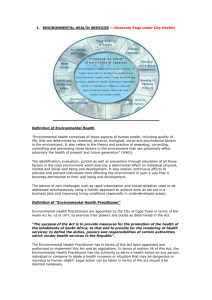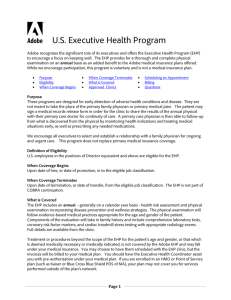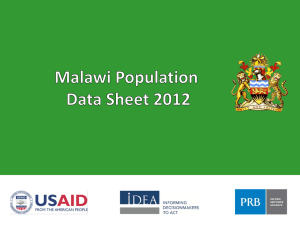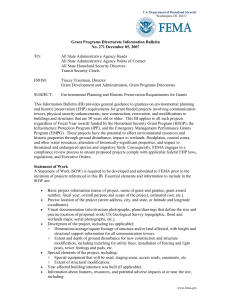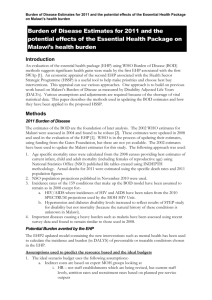Decentralisation of Home Based Care in Malawi
advertisement
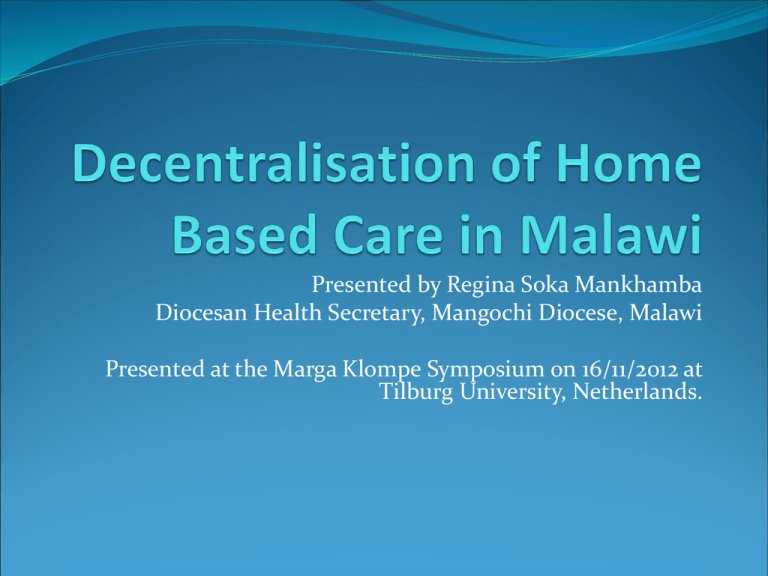
Presented by Regina Soka Mankhamba Diocesan Health Secretary, Mangochi Diocese, Malawi Presented at the Marga Klompe Symposium on 16/11/2012 at Tilburg University, Netherlands. Background Malawi is a small, narrow and landlocked country and shares boundaries with Zambia in the west, Mozambique in the east, south and south west and Tanzania in the north. In 2008, Malawi’s population was estimated at 13.1 million and growing at the rate of 2.8% per annum. one of the poorest countries in the world with a GDP per capita at US$290 in 2009. Poverty levels are high: in 2009 the proportion of the population living below the poverty line was estimated at 39%. DELIVERY OF HEALTH SERVICES IN MALAWI In Malawi health care services are delivered by the public and the private sector. The public sector includes all facilities under the Ministry of Health, Ministry of Local Government and Rural Development (MoLGRD), the Ministry of Forestry, the Police, Prisons and the Army. The private sector consists of private for profit and private not for profit providers (Christian Health Association of Malawi). The public sector provides services free of charge while the private sector charges user fees for its services. The objectives of the Health Sector Strategic Plan. Increase coverage of the high quality Essential Health Package services. Improve equity and efficiency in the delivery of quality EHP services. Strengthen the performance of the health system to support delivery of EHP services The Essential Health Package (EHP) An EHP for Malawi for the HSSP has been defined and it consists of the following conditions: (i) HIV/AIDS; (ii) ARI; (iii) Malaria; (iv) Diarrhoeal diseases; (v) Perinatal conditions; (vi) NCDs including trauma; (vii) Tuberculosis; (viii) Malnutrition; (ix) Cancers; (x) Vaccine preventable diseases; (xi) Mental illness and epilepsy; (xii) Neglected Tropical Diseases (NTDs); (xiii) Eye, ear and skin infections. The interventions for each of these diseases are those that have been proven cost effective. There are some interventions that are not cost effective but have been included because they are necessary. The EHP will be provided free of charge over the period of the HSSP. Decentralisation of health services The provision and management of health services has since been devolved to Local governments following the Decentralization Act (1997). The district or CHAM hospitals provide general services, PHC services and technical supervision to lower units District hospitals also provide in service training for health personnel and other support to community based health Programs in the provision of EHP. Health services are managed by the DHMT. The DHMT receives direct technical support and supervision from ZHSOs. Challenges to Decentralisation Linkage to local government. The MOHP has been pursuing a strategy of “selective deconcentration” whereby responsibility for certain functions have been delegated downwards. Management capacity of DHMTs. District level staff have not been adequately trained to take on extensive new management and planning responsibilities. Future status of vertical programs. The large number of vertical programs in the MOHP poses challenges for effective decentralization. The reorganization and integration of many of these programs will need to be addressed. Programmatic guidance must be retained at the central level. Linkage to the private sector. There is poor communication and coordination between the public sector, the private non-profit sector, and forprofit sector. MOHP documents do not include a role for the private sector (see Picazo and Marsh et al.1997). Decentralization will require much greater coordination between the public and private sectors. This includes CHAM, private for-profit providers, MOLG clinics, and large employers such as tea or tobacco estates. What the Catholic Health Commission, Mangochi Diocese is doing Health promotion promoting behavioural change for healthier life style Promoting community action and participation through the Village action committees in the communities Enabling Community Based Organizations for health promotion delivery Human resources for health Striving to provide human resource that is adequate, properly trained, remunerated, well motivated and capable of effectively delivering the EHP to the Malawi population. Strengthen human resource management for effective EHP delivery at all levels Improve retention of healthcare workers Mala South Bots Ghan Zamb Tanza wi Cadre Africa wana a ia nia 2004 Physi cians 69.2 28.7 9 6.9 2.0 1.1 Nurse s 388 241 64 113 35.0 25.5 Mala wi 2009 2.0 36.8 Drugs and medical supplies Ensuring availability, equitable access and rational use of good quality, safe, efficacious medicines and supplies at affordable costs. Strengthening collaboration with stakeholders in the pharmaceutical sector including the private sector. Health financing to the CBOs To increase financial resources and allocate them efficiently and equitably. Increasing overall financial resources at community level to allow multiplier effect Improving efficiency and equity in financial resource allocation; and utilization Promote community action and participation using PBF approach Support the implementation of community action interventions to address prioritised EHP health priorities Strengthen and sustain health facility and community structures in health promotion. Train community based workers on their roles and responsibilities. Support community structures to plan, implement and monitor health. These settings are empowered to set priorities, make decisions, plan strategies and implement them to achieve better health for themselves using the existing human and material resources.

